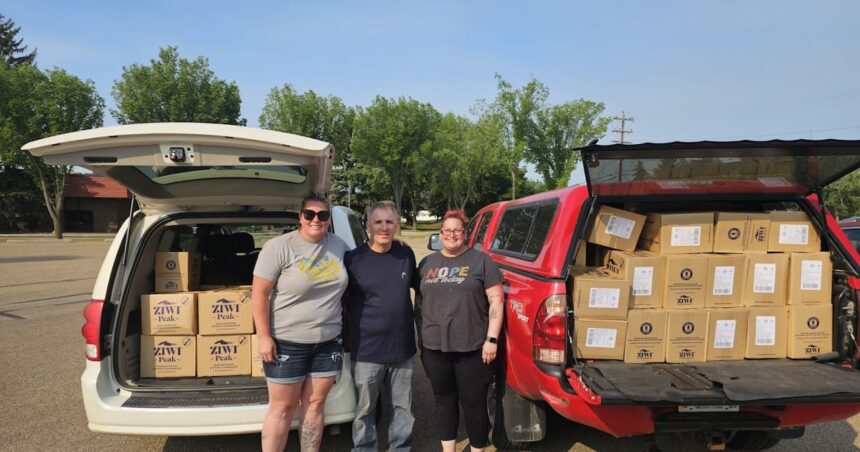The steady rumble of forklifts echoed through the Edmonton warehouse last Thursday as volunteers loaded pallets of pet food onto waiting trucks. For Jamie Ingram, watching this operation unfold has become both a source of pride and growing concern.
“We’ve seen a 60 percent increase in applications for our pet food assistance program over the past year,” said Ingram, communications manager for the Alberta SPCA. “That tells us families are struggling to keep pets in their homes.”
Nearly 23,000 bags of pet food are now making their way to communities across Alberta – from Lethbridge to Fort McMurray – in what has become the organization’s largest distribution effort to date. The Alberta SPCA’s One Family Welfare Pet Food Bank program has delivered over 141,000 kilograms of food to struggling pet owners since January.
Behind these impressive numbers lies a troubling reality. As inflation continues to squeeze household budgets, more Albertans are facing impossible choices between feeding themselves or their four-legged family members.
“We’re seeing a different demographic now,” noted Ken Grinde, a volunteer coordinator who’s been with the program since 2018. “It’s not just people living on the streets. We’re helping seniors on fixed incomes, families who’ve never needed assistance before, and people who’ve lost jobs in our province’s shifting economy.”
The need spans far beyond Edmonton’s city limits. Rural communities, often overlooked in conversations about poverty, have seen application rates double in some regions. The SPCA partners with 90 distribution agencies provincially, including food banks, animal rescues, and community outreach programs.
According to Statistics Canada data released this spring, Albertans are spending approximately 11.4% more on groceries than two years ago. Pet food costs have risen similarly, with premium brands seeing even steeper increases due to supply chain disruptions and ingredient costs.
For people like Margaret Townsend, a 72-year-old Edmonton resident, these increases hit especially hard.
“My pension doesn’t stretch like it used to,” Townsend explained while picking up a month’s supply of food for her 8-year-old retriever mix. “Without this program, I honestly don’t know what I’d do. Bailey is my only companion since my husband passed. I’d give up my own meals before I’d give her up.”
The program operates through a referral system, with applicants connecting through social agencies, veterinary clinics, or directly through the SPCA website. Once approved, recipients can access monthly supplies based on their pets’ needs.
What sets this initiative apart is its recognition that pet welfare and human welfare are deeply interconnected. Research from the University of Calgary’s Faculty of Veterinary Medicine shows that maintaining the human-animal bond during financial hardship significantly improves mental health outcomes for vulnerable populations.
Dr. Elena Contreras, a veterinarian who volunteers with the program, has witnessed this firsthand. “When people face housing instability or food insecurity, the emotional support from their pets becomes even more crucial,” she said. “Yet these are precisely the times when keeping a pet becomes most challenging financially.”
The Alberta SPCA emphasizes that the program represents more than just bags of kibble – it’s about preserving families.
“We’ve had people in tears telling us they were days away from surrendering their pets to shelters,” Ingram shared. “That’s not just a personal tragedy; it creates additional strain on animal welfare systems that are already at capacity.”
The initiative relies heavily on corporate partnerships and individual donations. Major pet food manufacturers like Purina and Hill’s have provided substantial contributions, while local businesses coordinate collection bins throughout the province.
Thursday’s distribution included not just dog and cat food, but also supplies for smaller pets like hamsters, birds, and reptiles. The program adapts to meet diverse needs, providing specialized diets for senior pets or animals with health conditions when possible.
Despite the impressive scale of operations, the program faces significant challenges. Warehouse space remains limited, transportation costs continue to rise, and demand shows no signs of slowing.
Provincial funding for animal welfare initiatives hasn’t kept pace with inflation or growing needs. The Alberta SPCA operates primarily through donations, with limited government support for its community outreach programs.
“We’re seeing similar trends across Canada,” noted Patricia Cameron, executive director of the Alberta Animal Rescue Crew Society, which partners with the SPCA on distribution. “The difference here is we’re trying to be proactive – keeping pets with their families rather than dealing with the aftermath of surrenders.”
For communities in northern Alberta, where both food costs and unemployment rates run higher than provincial averages, these deliveries represent a lifeline. The Lac La Biche Regional Humane Society reported receiving three times more inquiries about surrender alternatives compared to 2019.
Looking ahead, the Alberta SPCA is exploring ways to expand the program’s reach and sustainability. Plans include developing additional storage facilities in rural regions and creating education programs about affordable pet care.
“The reality is that we’re treating a symptom of broader economic challenges,” Ingram acknowledged. “But until those larger issues are addressed, we’ll be here making sure that families don’t have to choose between feeding themselves or the animals who give them comfort during difficult times.”
As the last truck pulled away from the warehouse, volunteers gathered for a quick debrief. There was pride in what they’d accomplished, but also recognition that another distribution would be needed soon. For the thousands of Albertans and their pets who will benefit from these supplies, it’s more than just food – it’s the chance to keep their families whole for another month.






